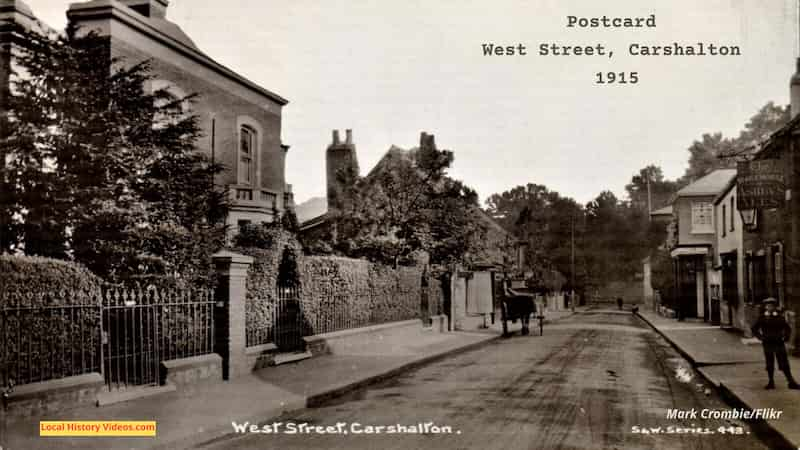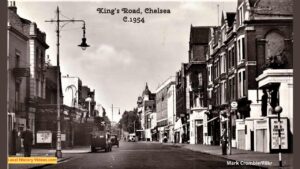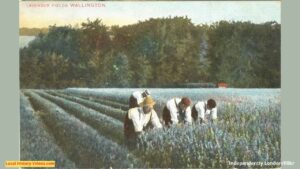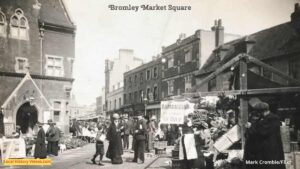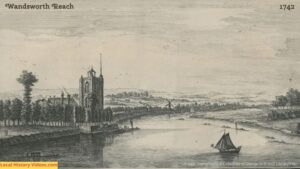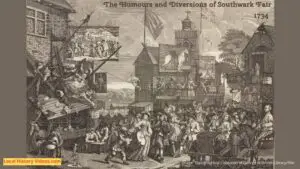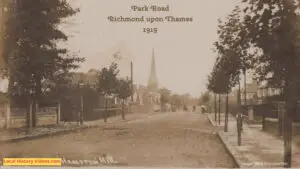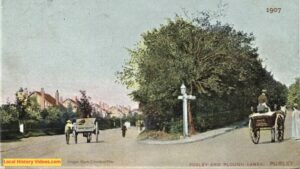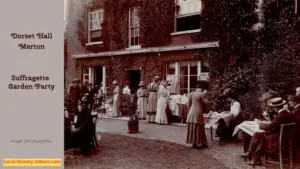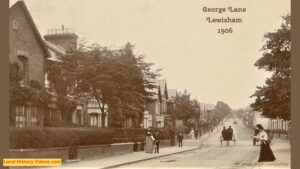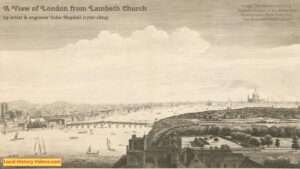Enjoy a glimpse of history through old images of Carshalton, in Greater London, England, UK.
Carshalton Motor Club
A number of short newsreels capture the area’s motocycle sports.
1926
Is Pillion Riding Safe? (1926) – British Pathé on YouTube
1927
Motorcycle race at Carshalton (1927) – British Pathé on YouTube
Is Pillion Riding Safe? (1927) – British Pathé on YouTube
Hot Walk (1935)
Kuda Box, from Kashmere, walked barefeet 25 feet across burning wood and charcoal, in front of an assembled group.
Fire walker walks on burning wood and charcoal (1935) – British Pathé on YouTube
Polio Victims
Silent, black and white footage recorded on 17th April 1947 shows child patients enjoying a range of art and reading exercises from their hospital beds in the open air.
The beds have wheels, so nurses can push the beds outside.
A few children are fully dressed and sitting on chairs around a table, but most of them are restricted to their beds as they learn.
Educating Children In Hospital (1947) – British Pathé on YouTube
The next two reels are from 1950 and 1951.
In the first, silent, black and white footage fro 1950 shows local adults affected by polio as they work in a welding workshop or visit the Infantile Paralysis Fellowship (IPF) building.
The second reel, from 1951, shows staff working with children to help them move their bodies and limbs, which have been seriously affected by this infectious disease.
The polio vaccine was introduced across the UK in 1956.
Polio (1950) – British Pathé on YouTube
Polio Treatment (1951) – British Pathé on YouTube
In 1960, about 60 child patients at Queen Mary’s Hospital were taken by coach and ambulance Kingston, to buy christmas presents for their parents.
Some of the children were in wheelchairs, but some were in a light portable bed, including 14 year old Peter Woods, significantly disabled after catching polio.
Young Patients Shop For Xmas (1960)- British Pathé on YouTube
Pre-fab Bathrooms (1966)
A row of local pre-war homes on the St. Helier estate were still using outside toilets and tin baths. One lady had installed a bath in her kitchen, with a lid to keep it out of sight when not in use.
Now pre-fab bathrooms delivered from County Durham were being installed onto the back of the houses, lifted over the roofs to the back gardens.
Harry Secombe’s Baby (1967)
Katherine Sian Secombe was born on 12th December 1967 at St Helier’s hospital in Carshalton. She was the fourth child of actor, singer and comedian Harry Secombe and his wife Myra.
Katie went on to become a professionally trained actor, working in West End.
Also in the newsreel is older sister Jennifer, who went on to marry actor and singer Alex Giannini following a period working full time while also single-handedly bringing up three young children from her first marriage. Jennifer worked in Entertainment Publicity for BBC television from 1985 until 2001, when she became freelance and enjoyed time with her six grandchildren. Alex died of a heart attack at the age of 57 in 2015, as he was about to perform on stage in Plymouth. Sadly, Jennifer suffered ill health before passing away in 2019.
Secombe’s Baby (1967) – British Pathé on YouTube
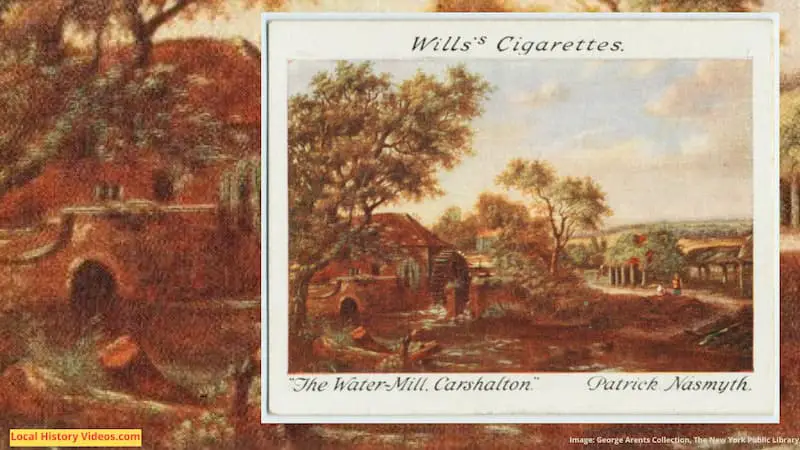
A Bit of Carshalton History
Extract from: “A Topographical History of Surrey – Volume 4“, by Edward Wedlake Brayley, John Britton, Edward William Brayley, and Gideon Algernon Mantell
Published in 1850
Pages 65 – 73
This parish, on the north side of the Downs, adjoins Beddington on the east; Sutton, on the west; Mitcham, on the north; and Wood mansterne, on the south. It contains about 2,200 acres; nearly in the proportion of seven of arable land to one of pasture.
Carshalton, (the Aultone, or Old Town, of the Domesday survey), is evidently a place of considerable antiquity. According to the probable conjectures of Salmon, Manning, and others, it acquired “the addition of Cross, Cross – Aulton, from some Cross in the neighbourhood, such being frequently to be met with at the intersection of great roads; and the rather, as there are lands in this parish, and partly in Beddington and Wallington, which were known by the name of Cross – lands.”
It appears that about the reign of King John, Cross – Alton had become Kresalton: the orthography has since varied in the records to Crossalton, Kersalton, and Carsalton; but it has, for nearly two centuries, been uniformly written Carshalton.
The Roman road, called the Stane – street, passes through this parish.
The manor is thus described in the Domesday survey: ” Goisfrid [ or Geoffrey ] de Manneville holds Aultone. Five free men held it of King Edward; and they could remove at pleasure. One of these men held 2 hides; and four of them 6 hides each. There were then five manors: now there is but one. It was then assessed at 27 hides: now at 34 hides. The arable land amounts to 10 carucates. One carucate is in demesne; and there are nine villains, and nine cottars, with 5 carucates. There is a Church and seven bondmen; and 12 acres of meadow. The men of the County, and of the Hundred, say they never saw writ or officer of the King, to give Goisfrid seisin of this manor. In the time of King Edward it was valued at 20 pounds; when Goisfrid took possession, at 100 shillings; and now at 10 pounds. ” Of these hides, Wesman holds 6 of Goisfrid the son of Earl Eustace, to whom Goisfrid de Manneville gave this land, with his daughter (in marriage). There is 1 carucate in the demesne; and three villains, and one cottar, with 3 carucates: and one mill at 35 shillings; and 3 bondmen; and 10 acres of meadow. The wood yields two swine for pannage. The arable land amounts to 2 carucates. In the time of King Edward it was valued at 4 pounds; afterwards at 40 shillings; now at 110 shillings. Of these hides a certain King’s Smith hath half a hide, which he received with his wife, in the time of King Edward; but he never did service for it. “
The manor of Carshalton, or Kersalton, was held in the reign of Stephen by Geoffrey de Magnaville, a grandson of the holder at the time of the Domesday survey. He was in high favour with the king; but being induced to desert his service for that of the empress Maud, his estates were confiscated, and this manor was given to Pharamus de Bolonia, nephew of the queen – consort of Stephen. Sibylla, the daughter and sole heir of Pharamus, transferred this estate, by marriage, to Ingelram de Fielnes, or Fiennes, although the superiority was vested in the Bohuns, earls of Hereford, who held the Honour of Magnaville, or Mandeville.
William de Fielnes, (descended from Ingelram and Sibylla,) in 1270, being about to go to the Holy Land, appears to have mortgaged Kersalton to his attorney, William de Ambesas; and his son, John de Fielnes, transferred his interest in the manor to William Medburn.
The manorial estate, burthened with the rent of twenty marks, which William de Fielnes had reserved when he conveyed it to Ambesas, came into the possession of Nicholas de Carreu, who had a grant of free – warren for his lands here in the 48th of Edward the Third; and in the 14th of Richard the Second, he died, seised of the manor, which was returned as of no value on account of the reserved rent charged on it.
It probably passed from the Carews, in consequence of the marriage of John St. John with the daughter of Sir Richard Carew. John St. John, the son of that lady, sold a moiety of the manor to Richard Burton, esq., in 1580; and is supposed to have sold the other moiety to W. Cole.
After several transfers, the latter moiety was conveyed, in 1655, to Thomas Twisden and others, as trustees for Sir Edmund Hoskins, serjeant – at – law; whose representatives, in 1696, sold it to Sir William Scawen; and he, about 1712, purchased the share which had belonged to the Burtons. Sir William died without issue, in 1722, and left the whole estate to his nephew, Thomas Scawen, esq.; whose son and heir, James Scawen, M.P. for Surrey, conveyed it to trustees for sale in 1781; and it was bought by George Taylor, esq., who died in 1834, and was succeeded by his nephew, John Taylor, esq., the present lord.
CARSHALTON PARK, with the mansion called Mascalls, belonged to Richard Burton, esq.; and being sold by one of his family to Sir Edmund Hoskins, it passed again by sale to Sir William Scawen. “
From the footnote: Sir Wm. Scawen was an eminent merchant in London, descended, as the inscription on his monument in the church states, of a Cornish family. He acquired a large fortune, and was elected one of the knights of the shire for this county in the 4th, 6th, and 7th of Queen Anne. He had risked nearly the whole of his property in the cause of William the Third. After having retired many years from his mercantile pursuits,”he one day, to the astonishment of every one, appeared again upon ‘ Change, when a broker asked him if there was any thing he could do for him ? You may, ‘ said Sir William, ‘ get me some bills upon Holland. ‘ Sir William did not despond. He went to the siege of Namur. The King hearing of it, sent to him, and said, ‘ Sir William, what do you do here ? ‘ Sir William replied, Please your Majesty, it matters not what becomes of me, if your Majesty should not return safe to England. ‘ The King returned safe, to the immense gain of Sir William.”- Manning, SURREY, vol. ii. p. 510.
His nephew and successor, Thomas Scawen, projected the building of a magnificent house here; and Leoni, an architect of some note in the earlier part of the last century, was employed in making designs for the mansion, which he published in his edition of the Architecture of Leo Baptista Alberti, about the year 1742; but Mr. Scawen did not carry his plan into execution.
Carshalton park, with the manorial estate, is now in the occupation of James Aitkin, esq. The wall surrounding it, which is about two miles in extent, commences not far from the church, on the right hand of the road to Beddington.
STONE COURT. – This appears to have been the estate of Bartholomew, Lord Burghershe, who, in the 18th of Edward the Third, obtained a grant of the right of free – warren for all his demesne lands in Kersalton. It afterwards belonged to the Gaynsfords of Crowhurst, and from them was called Gaynsford’s Place. Nicholas Gaynsford, sheriff of Surrey in the 38th of Henry the Sixth, was a partizan of the house of York, and was appointed an esquire of the body to Edward the Fourth, on his accession to the throne; but having in curred suspicion of treason against the new king, a writ was issued for the seizure of his manor of Burghershe alias Kersalton, and, also, that of Shalford Clifford, which Edward had bestowed on him. He recovered possession of the former estate, though not of the latter; and he repeatedly held the office of sheriff of Surrey in the reigns of Edward the Fourth and Richard the Third. After the accession of Henry the Seventh, he acquired the favour of that prince, who made him one of the esquires of his body; and he was one of the principal attendants on the queen, in her procession from the Tower to Westminster, previously to her coronation. Henry Gaynsford, who held this estate in the 38th of Henry the Eighth, alienated about three hundred acres to Sir Roger Copley: he also demised the site of the manor of Stone Court to Walter Lambard, for ninety – nine years, reserving a rent of 12d. Lambard erected a handsome house here, which became the property of Sir Henry Burton, and afterwards of Joseph Cator, who (in 1729) sold it to Thomas Scawen, esq.; and the trustees of his son, James Scawen, transferred it by sale to William Andrews, esq., in 1781. The house, which had retained the name of Gaynsford’s Place, was pulled down about the year 1800.
The manor of Kymersley, which, at one time, belonged to the Burtons, and an estate named Crosse – lands, held by the same family in the time of Henry the Eighth, cannot be traced in modern times.
Carshalton, celebrated by Fuller for “trout and walnuts,” obtained from Henry the Third the grant of a weekly market on Tuesday; and an annual fair for three days, on St. Mary’s day, the vigil, and day following.
The Wandle, still abounding with trout, passes through the parish; and, increased by other streams, and several springs which rise there, forms a large pool of remarkably clear water, nearly in the centre of the village.
On the banks of the stream are ten mills: four of them for flour; two for the purposes of leather – dressing; two snuff mills; one flax mill; and one paper mill. The following is their order on the stream; with their respective purposes, the names of their owners and occupiers, & c.
- A snuff – grinding mill; very powerful at times: the property of Jonah Cressingham, esq. of Carshalton; occupied by Francis Phillips.
- A hemp – spinning mill, of small power: the property of Mr. Andrews, of Bath; occupied by George Kinnell.
- A flour – mill, with five pair of stones, & c.: bought by Mr. Newton, of Wandsworth, and believed to be the property of Robert Connington, the occupier.
- A paper – mill, with five vats: the property of the occupier, Mr. John Muggridge, of Carshalton.
- A snuff – grinding mill, of 16 – horse power for twelve hours: the property of Edward Tyrrell, esq., the City Remembrancer; occupied by Robert Ansell.
- A flour – mill, of 16 – horse power for twelve hours: also the property of Mr. Tyrrell; occupied by John Ashby.
- A leather – dressing mill: the property of Miss Shipley, of Wandsworth; occupied by William M Ray.
- A flour – mill, with three pair of stones: the property of Mr. Thomas Reynolds, of Wallington; unoccupied.
- A leather – dressing mill, powerful: the property of Mrs. Esther Reynolds, of Trawling; occupied by William Me Ray.
- A flour – mill, with three pair of stones: the property of Mrs. Spencer, of Banstead – Park; occupied by John Searle.
Nearly close to the western boundary of the churchyard, is a neatly kept well of the purest water, which tradition has connected with the memory of Anne Boleyn. According to report, the spring arose suddenly from a hole into which her horse had accidentally struck its foot whilst pacing here.
The principal mansion in this parish is CARSHALTON HOUSE, Occupying the site of a residence built by the celebrated Dr. Radcliffe
From the footnote: Dr. Radcliffe, remembered for his eccentricities, and as the founder of the Radcliffe Library, at Oxford, for which he bequeathed forty thousand pounds, was one of the physicians of William the Third, and of the Princess (afterwards Queen) Anne. He died in 1714, at the age of sixty – four. His house at Carshalton was sold for 3,500L to Sir John Fellowes, sub – governor of the South – Sea Company, by whom it was rebuilt; at which time, says Aubrey’s Editor, (SURREY, vol. ii. p. 174,) in levelling the ground to make an avenue, many bones, supposed to be human, were found. The house afterwards belonged to the Lord – Chancellor Hardwicke; then to the Hon. Thomas Walpole, who sold it to John Hodson Durand, esq.; of whom it was purchased by David Mitchell, esq. At the time when Lysons wrote, it was the property of Theodore Broadhead, esq.
and purchased about four years ago by Edward Simeon, esq., nephew of the late Rev. Charles Simeon, of Cambridge, and brother of Sir Richard Simeon, bart., of Ryde in the Isle of Wight. It is a good specimen of the old English brick mansion.
The Rectory, which was given by Pharamus de Bolonia to the Prior and convent of Merton, was vested in the crown in 1549. Sir William Goring held it in 1554; and John Fromond in 1568. It passed from the heirs of the latter to the family of Bynde, or Byne. Henry Byne, of Carshalton, who died in 1697, gave a moiety of the tithes to the vicar of the parish; and his son Henry, by will dated March 26th, 1723, settled the remainder in the same manner, subject to the life – interest of his wife.
The patronage is now vested in John Cator, esq. Rectors of Carshalton in and since 1800:
WILLIAM ROSE, M.A. Instituted in January, 1777: died on the 10th of April, 1829.
CHARLES CATOR (now rector of Stokesley in Yorkshire). Instituted in 1829: resigned.
WILLIAM HARDY VERNON, B.A. Instituted July 15th, 1835.
The Church, which is in the deanery of Ewell, and situated on a rising ground near the centre of the village, is dedicated to All – Saints.
In the Valor of 20th Edward the First, the rectory is rated at twenty one marks; the vicarage, at six marks and forty pence. It is discharged in the King’s books; but pays for procurations 7s. 6 d., and for synodals, 2s. 1d.
In its present state, the church consists of a nave, with a chancel, two aisles, and a low embattled tower (containing eight bells) between the chancel and the nave. There can be no doubt, however, that what is now the chancel was originally the entire church, having the tower at the west end. The chancel, composed of rubble – stones and flint, is unquestionably ancient. The aisles are separated from the nave by ancient and dissimilar columns, of rude workmanship, supporting three pointed arches on each side: their capitals are enriched with sculptured foliage.
The upper parts of both aisles were rebuilt with brick, and raised for the purpose of erecting galleries, about the beginning of the last century, chiefly at the expense of Sir John Fellowes and Sir William Scawen: the upper part of the tower is of freestone.
In 1811, the church underwent a thorough repair; and, about seven or eight years ago, during the residence of the present incumbent, several important alterations and improvements were effected. Amongst others, a screen was erected in front of the altar – piece; by which means, the eastern end of the chancel was converted into a large, light, and commodious vestry; and what was formerly the vestry, at the west end, was taken into the body of the church. At the same time, the organ – gallery was brought considerably forward: additional room was thus gained; and the church, which is ninety – nine feet in length, by thirty – seven feet and a half in breadth, now accommodates a congregation of about nine hundred persons.
From the footnote: Lysons has expressed an opinion, but we feel his reasoning to be contradictory rather than conclusive, that the church was built in the reign of Richard the Second. The data on which he founds this opinion are, that previously to the alterations during the eighteenth century, there were, in the windows of the north aisle, the arms of Burley and Sarnesfield, with the Order of the Garter, and those of John Beaufort, earl of Somerset, without that distinction; that Simon, Richard, and John Burley were elected knights of the Garter in the reign of Richard the Second; and that the Earl of Somerset was afterwards of that Order, but not elected till the reign of Henry the Fourth. The architecture of the chancel, he says, confirms the above conjecture; but the columns which separate the nave from the aisles, appear to be of a more remote age; and, further, he states that, in the Registry at Winchester, there is a commission, dated in 1324, for reconciling the church of Carshalton which had been polluted by the death of Thomas Gruton. [ ENVIRONS, Vol. i. p. 126 ]. Now, Richard the Second did not begin to reign until the year 1378. The chancel, which (as we have already remarked) is the most ancient portion of the building, and originally constituted the entire church, is of a much earlier period. It is probable, however, that additions were made in the reign of Richard the Second.
In this church are some fine brasses, ancient monuments, and in scriptions; accounts of which are preserved in Manning and Bray: several others that were in existence in Aubrey’s time, are now lost.
Against the wall, on the north side of the altar, in what is now the vestry, is an altar – tomb of Purbeck marble; over which, affixed against the wall, is a large slab of the same material, inlaid with the brass figures of a man and woman at prayer. The man is in armour, on one knee, with his gauntlet and sword at his feet; and behind him, are his four sons; the eldest in armour as an esquire; the second, habited as a priest; and the third and fourth, as merchants. Before the woman is a desk, with an open book upon it; behind, are her four daughters. Beneath, is the following inscription:
Pray for the Soulys of Nicholas Gaynesford, sometime Esquer for the body of the most noble princes Edward the IIII. and Henry the VII and Margaret his wyfe, also one of the Gentilwymmen of the most noble p’ncesses Elizabeth and Elizabeth, wyfes of the forsaid most noble p’nces kynges. The which Nicholas vecesid the (blank) day of (blank) in the yere of oure Lord God a mccc, and the forsaid Margaret Disceyd the (blank) day of (blank) in the yere of oure Lord God a thousand cccc. On whoos sowlles J’hu have mercy. Amen.
Traces of the gilding and painted fillings – up of the brass figures on the slab are still visible. The lady’s head – dress, remarkable for its size, corresponds with other specimens of the same date; her robe, which has close sleeves, is red, edged with gold. Over the heads of the figures are some armorial bearings in brass.
On the south wall of the vestry (or chancel), is a small mural monument, of black marble, equally curious for the facts which it records, and for the style of the record. The inscription is as follows: M. S.
Under the middle stone y guards ye ashes of a certayne fryer, sometime Vicar of this place, is raked up ye duste of WILLIAM QUELCHE, B.D. who ministred in y same since the Reformac’on. His lott was, through God’s mercy, to burne incense here about 30 y, and ended his course Aprill the 10, anº D’ni 1654, being aged 64 years. 1 Reg. 13, 31.
Quos bifrons templo divisit cultus in uno
Pacificus tumulus jam facit esse pares;
Falix illa dies, quæ cultus semina solvit,
Que placida fidei media condit humo.
Hic sumus ambo pares, donec cineremq; fidemq;
Discutiat reddens Christus utriq; suum.
Those whom a two fac’t service here made twaine,
At length a friendly grave makes one again.
Happy that day that hides of sinful jarrs,
That shutts up al o shame in earthen barrs:
Here let us sleepe as one, till C ye juste
Shall sever both of service, faith, and duste.
Near the above – mentioned tablet, is a monument of a costly and imposing character, to the memory of HENRY HERRINGMAN, (citizen and stationer of London), and Alice his wife, who were married September 29th, 1650, and lived 58 years and upwards very happily and comfortably together, and dyed within six weeks and two days of one another.
On the opposite side of the vestry is a mural monument of the Taylors, lords of the manor.
Also, one to the memory of the Rev. WILLIAM ROSE, who died on the 10th of April, 1829; having been ” fifty – two years rector of Carshalton, and of Beckenham, in Kent. ”
At the east end of the north aisle is a large, massive, tasteless monument of veined marble, to the memory of Sir JOHN FELLOWES, bart., who died in July, 1724, at the age of fifty – three. –
In a corresponding situation, at the end of the south aisle, is a handsome monument, supported by Corinthian columns and pilasters, to the memory of Sir WILLIAM SCAWEN, M.P., who died at the age of seventy – five, on the 17th of October, 1722; and is represented by a statue of white marble, in a loose robe and flowing peruke, reclining on his left arm.
In the south aisle, also, is a monument of black marble, supported by columns of the Ionic order, to the memory of Sir EDMUND HOSKINS, knt., serjeant – at – law, who died in 1664.
On a stone in the north aisle, commemorating Johan, the wife of Henry Burton, esq., who died in 1624, is a brass figure of a woman praying, with a scroll issuing from her mouth, inscribed “O blessed Lady of pittie, p’y for me, y my soule savyd may be”.
On the right and left of the entrance to the chancel from the nave, are two small but beautifully – executed mural monuments, in white marble, by Physick. The former represents a youthful female, attendant on the death – bed of her brother, MICHAEL SHEPLEY, esq., who died on the 21st of March, 1837: this monument was erected by the sisters of the deceased.
The monument on the left, to the memory of Susanna Shepley, (one of the sisters), who died February the 19th, 1840, represents a female resting, mournfully, on a cenotaph surmounted by an urn.
There are various other monuments in this church well deserving of notice, but of which our limits will not admit particulars.
From the footnote: Lysons has preserved the following inscription, from the tomb, or grave – stone, of Thomas Humphreys, a harber, (noted equally for his corpulence and his activity as a dancer), in the churchyard
“Tom Humphreys lies here, by death beguil’d
Who never did harm to man, woman, or child;
And since without foe, no man was e’er known,
Poor Tom was nobody’s foe but his own;
Lay light on him earth, for none would than he
(Though heavy his bulk) trip it lighter on thee.
“Died Sept. 4, 1742, aged 44 years. “
The pulpit and reading – desk are of oak and plain; the former is of an hexagonal form. The font, standing in front of the communion – table, is small and of stone.
The Registers of this parish, commencing in the year 1538, are comprised in two books; the first of which appears to have been well kept, excepting that (owing to the troubles of the times) it contains no entries from 1644 to 1651.
The more modern book begins in 1703; and, from 1708, it has been kept with great accuracy. The date of birth, as well as of baptism, is entered; a system which, whenever it be practicable, ought to be enforced.
In the old register is an entry, under the date of March the 3rd, 1569-70, referring to the celebration of the funeral here, of Sir Nicholas Throckmorton, knt.; who had an occasional residence at Carshalton, but the actual place of his interment was in London, in the church of St. Catherine Cree, where a splendid monument of alabaster was erected to his memory. He was celebrated both as a soldier and statesman; and acquired so much of the royal favour of queen Elizabeth, that the earl of Leicester regarded him as a formidable rival, and is suspected to have hastened his death by poison,v”as he died suddenly at the earl’s house, near Temple Bar, after eating a hearty supper”.
The only dissenting place of worship in Carshalton is a small chapel for Wesleyan – methodists.
More Pictures of Old Carshalton
Old Carshalton in London, England, enjoyed through historic photos, vintage pictures & archive film. Browse history in these fascinating old images of a bygone era on my Pinterest Board at:
https://www.pinterest.co.uk/LocalHistoryVideos/carshalton-old-photos-pictures
More Greater London
- Chelsea, London: History in Old ImagesEnjoy a glimpse of history through old images of Chelsea in Greater London, England, UK.
- Wallington, London: History in Old ImagesEnjoy a glimpse of history through old images of Wallington, in Greater London, England, UK.
- Bromley, London: History in Old ImagesEnjoy a glimpse of history through old images of Bromley, in London, England, UK.
- Old Images of Wandsworth, LondonGlimpse history through old images of Wandsworth, London, England, UK.
- Old Images of Southwark, LondonGlimpse history through old images of Southwark, London, England.
- Old Images of Richmond upon Thames, LondonGlimpse history through old images of Richmond upon Thames, London, England, UK.
- Old Images of Purley, LondonGlimpse history through old images of Purley, London, England, UK.
- Old Images of Merton, LondonGlimpse history through old images of Merton, London.
- Old Images of Lewisham, Southeast LondonGlimpse history through old images of Lewisham, in Southeast London, England.
- Old Images of Lambeth, LondonEnjoy a glimpse of history through old images of Lambeth, London, England.

